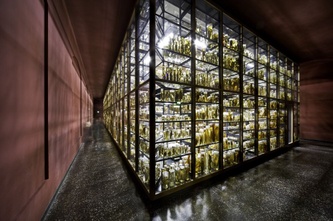Permafrost soil thawing accelerates climate change despite more abundant vegetation
2013/03/13 - Global warming affects permafrost soils, for instance in Siberia, in two opposing ways. Their thawing accelerates decomposition processes in the soil, leading to higher CO2 emissions. On the other hand, enhanced vegetation growth due to higher temperatures leads to carbon intake by the plants, and consequently storage in the soil. However, the – often neglected – second effect in the long run cannot counter the first one, reveals a study now published by scientists of the Potsdam Institute for Climate Impact Research.
Read More
Naturkundemuseum and PIK link history and future
03/08/2013 - Naturkundemuseum Berlin, Germany´s leading natural history museum, and the Potsdam Institute for Climate Impact Research have agreed to work closer together at a meeting in early March. When a delegation from the museum, led by its Director-General Prof. Dr. Johannes Vogel, visited PIK, a number of ideas for a closer cooperation were identified.
Read More
Weather extremes provoked by trapping of giant waves in the atmosphere
02/25/2013 - The world has suffered from severe regional weather extremes in recent years, such as the heat wave in the United States in 2011 or the one in Russia 2010 coinciding with the unprecedented Pakistan flood. Behind these devastating individual events there is a common physical cause, propose scientists of the Potsdam Institute for Climate Impact Research (PIK). The study will be published this week in the US Proceedings of the National Academy of Sciences and suggests that man-made climate change repeatedly disturbs the patterns of atmospheric flow around the globe's Northern hemisphere through a subtle resonance mechanism.
Read More
Global warming has increased monthly heat records by a factor of five
01/14/2013 - Monthly temperature extremes have become much more frequent, as measurements from around the world indicate. On average, there are now five times as many record-breaking hot months worldwide than could be expected without long-term global warming, shows a study now published in Climatic Change. In parts of Europe, Africa and southern Asia the number of monthly records has increased even by a factor of ten. 80 percent of observed monthly records would not have occurred without human influence on climate, concludes the authors-team of the Potsdam Institute for Climate Impact Research (PIK) and the Complutense University of Madrid.
Read More
Why early Earth was no snowball: Illuminating the ”faint young Sun paradox”
12/17/2012 - In the early history of planet Earth, the Sun was up to 25 per cent less luminous than today. Yet there is strong evidence that the Earth’s oceanic surface was not completely frozen. High concentrations of warming greenhouse gases like carbon dioxide (CO2) seem to be the most obvious solution to this famous “faint young Sun paradox”. A team of scientists from the Potsdam Institute for Climate Impact Research (PIK) analyzed in computer simulations how much CO2 in the atmosphere was necessary to prevent the early Earth from falling into a “snowball state”. They found the critical amount to be significantly higher than previously assumed, according to their study now published in Geophysical Research Letters. This sheds light on the environment on early Earth during a time when life first appeared on our planet.
Read More
Projected sea-level rise may be underestimated
11/28/2012 - The rate of sea-level rise in the past decades is greater than projected by the latest assessments of the IPCC, while global temperature increases in good agreement with its best estimates. This is shown by a study now published in the journal Environmental Research Letters. Stefan Rahmstorf from the Potsdam Institute for Climate Impact Research (PIK) and his colleagues compare climate projections to actual observations from 1990 up to 2011. That sea level is rising faster than expected could mean that the Intergovernmental Panel on Climate Change’s (IPCC) sea-level rise projections for the future may be biased low as well, their results suggest.
Read More
„Clouds, wind and weather“ is green book of the year
09/26/2012 - For its “lasting impact on ecological awareness in Germany”, PIK-scientist Stefan Rahmstorf´s children´s book “Clouds, wind and weather“ was elected green book of the year 2012 last night. The price is awarded by the German Environment Foundation and the editorial team of “Jahrbuch Ökologie”.
Read More












